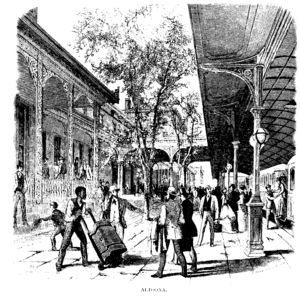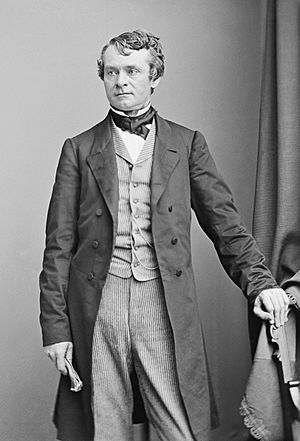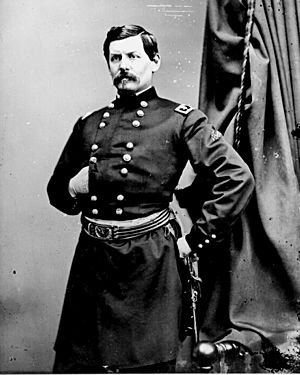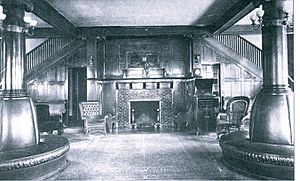War Governors' Conference facts for kids
The Loyal War Governors' Conference was a very important meeting during the American Civil War. It happened at the Logan House Hotel in Altoona, Pennsylvania, on September 24 and 25, 1862. Thirteen governors from Union states met to talk about the war. They discussed how their states could help, how many soldiers each state should provide, and how to support President Abraham Lincoln. They also wanted to show their support for his Emancipation Proclamation. The governors even suggested that General George B. McClellan should no longer lead the Army of the Potomac. Pennsylvania Governor Andrew Gregg Curtin organized and hosted the meeting. He strongly supported the war and Lincoln's plans. This meeting gave President Lincoln much-needed support from the Northern states.
Contents
Why the Meeting Happened
In the late summer of 1862, the war was not going well for the United States and President Abraham Lincoln. Lincoln, who was the Commander-in-Chief, wanted to announce a special order. This order would free enslaved people in the Southern states. However, he was worried that the border states (which still allowed slavery) might leave the Union if he did this too soon.
Lincoln needed a big military victory before he could announce the Preliminary Emancipation Proclamation. If he announced it without a victory, it might look like a desperate move.
On September 6, Governor Andrew Gregg Curtin of Pennsylvania sent out a telegram. He invited all Union governors to meet and discuss their states' roles in the war. Governor Andrew of Massachusetts, who sometimes disagreed with Lincoln, supported the meeting. He hoped it would lead to stronger actions, like freeing enslaved people. He believed this was the only way to win the war. Altoona, Pennsylvania, was chosen as the meeting place.
The Battle of Antietam and the Location
The Battle of Antietam happened on September 17, 1862. This battle gave Lincoln the victory he needed. It became a major topic for the governors to discuss. The state leaders started arriving at the Logan House Hotel in Altoona on September 23.
Altoona was a perfect spot for the meeting. It was easy to reach from both the Midwest and New England. The city also had great transportation and luxury because of the huge Pennsylvania Railroad center there. During the Gettysburg Campaign, Confederate General Robert E. Lee even thought about attacking Altoona if his army got that far.
Guests and Sightseeing
As more governors and their helpers arrived, local people and politicians gathered. They stood on the train platform next to the hotel to see the important guests. Even General John Alexander McClernand and his team, who were just passing through, stopped to watch. A reporter from the New York Herald was also there. His article about the conference appeared on the front page of the newspaper on September 29, 1862.
The day before the meeting, the governors who had arrived went on a sightseeing trip. They visited the famous Horseshoe Curve. This trip was a gift from John Edgar Thomson and the Pennsylvania Railroad.
The Meeting Begins
The meeting started the next morning. Eleven governors, one representative, and several aides were present. Governor Curtin welcomed everyone, and then the group immediately got to work. They discussed many topics. These included how they could support the Preliminary Emancipation Proclamation. They also talked about how their individual states could help the war effort.
Debate About General McClellan
One of the main topics was General George B. McClellan. He was the commander of the Army of the Potomac. Governor John Albion Andrew of Massachusetts spoke up and openly criticized General McClellan's leadership. Governor William Sprague IV of Rhode Island agreed. He said the Battle of Antietam, fought less than a week earlier, was "a rebel victory." He believed the Confederates did not retreat because they were defeated. Instead, he thought they showed great military strategy.
Governor David Tod of Ohio said he did not understand why some wanted to remove McClellan. He stated he would block any attempt to do so. The debate continued until 12:30 a.m. before the topic was finally finished.
The Final Address
Despite many heated debates, all governors except Augustus Bradford of Maryland agreed to the final statement. Bradford's disagreement was likely because Maryland was still a slave state. In the morning, Governor Austin Blair of Michigan arrived late. He joined the other delegates in going to Washington, D.C. that same day. With Blair's name, a total of twelve signatures were on the statement presented to the president.
No official notes of the meeting were kept. This was for security reasons. Perhaps because of this, historians often overlook this event.
When the group reached the White House on September 26, they read their document. It stated that the president's "rightful authority" and "the constitutional powers of Congress" protected "the rights and liberties of the people." The governors promised to "continue in the most vigorous exercise of all our lawful powers." They would keep fighting against "treason, rebellion, and the public enemies until final victory." The statement also encouraged "the military education of the people."
Lincoln accepted their suggestions for managing the war. These included ideas for recruiting soldiers and transporting troops. However, the meeting became tense when Governor Kirkwood of Iowa suggested that General McClellan was not fit to lead. Lincoln refused to argue about it and quickly ended the meeting. Nevertheless, McClellan was removed from his command less than two months later. The Emancipation Proclamation officially began on January 1, 1863.
The statement was also sent to other Union governors who could not attend. The governors of Vermont, Connecticut, Kansas, Minnesota, and Oregon all approved the document. However, the governors of New York, New Jersey, Delaware, Kentucky, and Missouri refused to approve it. The last three were still slave states.
Impact of the Meeting
The Loyal War Governors' Conference is often forgotten in the history of the American Civil War. However, it played an important part in Abraham Lincoln's decisions. The President now had strong support from the Northern states to finish the war. For the 50th anniversary of the event, the Altoona Mirror newspaper wrote about it. It said, "It was this conference...which more than any other thing strengthened Lincoln's hands in the darkest hour of the war period."
The Emancipation Proclamation legally freed enslaved people in the states that had left the Union. It also freed them in parts of states not controlled by the Union army. It did not affect slavery in the border states. It also did not affect areas of Virginia, Tennessee, and Louisiana that the Union army already controlled.
The proclamation also influenced countries like Britain and France. It made them less likely to recognize the Confederacy. People in those countries generally did not support states that allowed slavery.
Interestingly, Lincoln suspended the Writ of Habeas Corpus in the United States on the same day the governors met in Altoona. It is not known if these two events are connected. However, because of the Altoona meeting, Lincoln was able to issue the Emancipation Proclamation. He did so with new confidence and commitment from the Northern governors and the victory at Antietam.
Governors Who Attended
| Governor | State | Approved Declaration |
|---|---|---|
| John A. Andrew | Massachusetts | Yes |
| Nathaniel S. Berry | New Hampshire | Yes |
| Austin Blair | Michigan | Yes |
| Augustus Bradford | Maryland | No |
| Andrew G. Curtin | Pennsylvania | Yes |
| Samuel Kirkwood | Iowa | Yes |
| Oliver P. Morton
(represented by D.G. Rose) |
Indiana | Yes |
| Francis H. Pierpont | Virginia (Loyal) | Yes |
| Edward Salomon | Wisconsin | Yes |
| William Sprague | Rhode Island | Yes |
| David Tod | Ohio | Yes |
| Israel Washburn | Maine | Yes |
| Richard Yates | Illinois | Yes |
The Logan House Hotel and its History
The Logan House Hotel, where the conference took place, was built in 1854 by the Pennsylvania Railroad. It was called "Mansion in the Wilderness." At the time, it was one of the grandest hotels in the country. It had 106 rooms, gas lighting, and hot running water. People thought it was one of the most modern hotels of its time. One visitor even joked that the hotel was "about the size of Rhode Island."
Famous people who stayed at the hotel included presidents Ulysses S. Grant, Rutherford B. Hayes, and William Howard Taft. Mary Todd Lincoln and her children spent a few summer days there. They wanted to escape the heat and crowds of Washington, D.C.. Just one year after the Governors' Conference, David Wills of Gettysburg held a meeting there. This meeting started the plans for the Gettysburg National Cemetery. Lincoln would later give his famous Gettysburg Address there. The hotel closed in 1927 and was torn down in 1931. Today, the Altoona Post Office stands on that spot.
50th Anniversary Celebration
In 1912, a huge ceremony was held in Altoona. It celebrated the 50th anniversary of the conference. All the Northern governors of the states at that time attended. Even President Taft came to Altoona to join the fun and give a speech to the large crowds.
According to old photos and stories, there were decorations and special events everywhere. A huge parade was held on 11th Avenue downtown. This parade included old veterans of the Civil War. It also featured a massive float with a model of the USS Monitor, which even had a spinning turret. Many other large floats were entered by local groups. At the Cricket Field sports arena, a big festival took place. It had vendors, food, and souvenirs to help remember the event. Today, a shopping area stands where the Cricket Field used to be, in front of the Altoona Regional Hospital.
|





